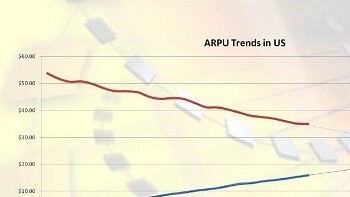

The biggest growth area? Smartphones. They now account for 31% of all phones on carriers. Additionally, the average mobile subscription uses 230 MB of data a month, which is huge when you consider that the average mobile subscriber doesn’t have a smartphone. Not surprisingly, AT&T and Verizon make up 70% of mobile data services; they also have a combined 62% of all mobile subscribers.
What’s really interesting in the report is what it says about trends in peoples’ mobile usage. Tech geeks who think of their phones more as computers than as devices you talk into won’t be surprised to learn that this is going to be the status quo soon. Since the third quarter of 2004 through present, average revenue per user (ARPU) for voice has gone down from about $54 to $36, while the revenue from data over the same period has gone from $3 to $16. If these numbers continue to change at roughly the same rate, then we can expect people to be paying for their phones more for data use than for voice use.
This is particularly fascinating when coupled with the fact that voice traffic on mobile networks has held stable since 2007, with only a minor tendency towards growth. By comparison, data has grown exponentially. If my read on this is correct, voice accounts for about 2 terabytes a year of mobile traffic, while data accounts for closer to 9.6 terabytes.
I’m sure there are a lot of other notables in this report that I’m not going to get into, so I recommend giving it a read. It’s attached as PDF below.
Get the TNW newsletter
Get the most important tech news in your inbox each week.
